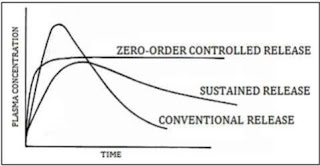CLINICAL IMPORTANCE OF THE ELIMINATION RATE CONSTANT,HALF-LIFE,TOTAL BODY CLEARANCE, VOLUME OF DISTRIBUTION
CLINICAL IMPORTANCE OF HALF-LIFE
The half-life is the parameter that reflects the rate of drug elimination, similar to the elimination rate constant. Drugs that have a short half-life (large elimination rate constant) are eliminated from the body faster than drugs with a long half-life.
Drugs that have a short half-life need to be given more frequently during multiple administrations; drugs with a long half-life should be given less frequently. Also, drugs given to patients who have a dysfunction of the organ responsible for the elimination of a drug have a longer half-life compared to those given to patients with normal function of the eliminating organ. For example, the half-life of aminoglycoside is much longer in patients with kidney failure compared to the half-life in patients with normal kidney function. This is because the aminoglycoside antibiotics are eliminated primarily by the kidney.
CLINICAL IMPORTANCE OF TOTAL BODY CLEARANCE
For the same drug (the same Vd), a decrease in drug CLT means a slower rate of drug elimination. So, patients with different degrees of eliminating organ dysfunction who are taking the same drug eliminate the drug at different rates and may require dosage adjustment according to the degree of dysfunction. The CLT of the drug can be used as a monitoring parameter for the function of the eliminating organ of the drug.The clearance of some specific markers can be used to determine the function of the eliminating organ of this marker. For example, creatinine is an endogenous byproduct of muscle metabolism that is excreted only by the kidney. The clearance of creatinine is used as a measure of kidney function. A decrease in kidney function results in lower creatinine clearance.
CLINICAL IMPORTANCE OF VOLUME OF DISTRIBUTION
Most drugs have a specific therapeutic range in which the drug is most likely to be effective with minimum adverse effects. So, the goal is to achieve a specific drug blood concentration. The volume of distribution allows calculation of the dose required to achieve a certain blood concentration of the drug, as in Equation :
Dose = Cpdesired × Vd
The volume of distribution also allows calculation of the expected drug blood concentration achieved after administration of a certain dose. Increasing the dose in a given patient results in a proportional increase in the initial drug blood concentration (because Vd is constant), and the drug blood concentration–time profiles decline with the same slope because the elimination rate constant is similar. Drugs that are extensively distributed to the tissues will have a large volume of distribution and will require larger doses to achieve a certain drug blood concentration.
CLINICAL IMPORTANCE OF THE ELIMINATION RATE CONSTANT
When comparing a group of drugs, a larger elimination rate constant means a faster rate of drug elimination from the body. Drugs that are eliminated rapidly from the body have a shorter duration of effect after single-dose administration. This is Because the amount of the drug in the body will fall below the effective level quickly. During multiple administrations, drugs that are eliminated rapidly from the body will need to be given more frequently to maintain an effective drug level in the body; Slowly eliminated drugs should be given less frequently. For example, penicillin G is eliminated from the body quickly, so it is usually administered every 4–6 hr, and a drug like digoxin, which is eliminated slowly from the body, is usually administered once every day. Patients who have dysfunction in the organ responsible for the elimination of a drug usually eliminate the drug at a slower rate compared to patients with a normally functioning eliminating organ.
So, patients with dysfunction in the eliminating organs require smaller doses of the drug (or doses should be administered.
For example, patients with kidney failure require smaller doses of aminoglycoside antibiotics compared with patients with normal kidney function. This is because the aminoglycoside antibiotics are eliminated by the kidney, and kidney dysfunction slows the rate of their elimination.




Comments
Post a Comment
Thanks